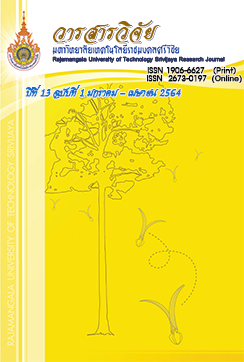Effects of Fruit Harvesting Periods, Tree Ages and Fruit Development Periods on Fruit Quality of Neck Orange
Keywords:
tree age, fruit age, fruit development, fruit quality, Neck orangeAbstract
Effects of fruit harvesting periods and fruit development periods on fruit quality of neck orange. The experimental was used 2x5 factorial in completely randomized design (CRD) with single tree plots and replicated five times. The treatments included 2 factors ; A : the different time of harvesting (the beginning of the year, and the end of the year) B: the different age of pomelo fruit (5th 6th 7th 8th and 9th months), the experiment was conducted at the orchard of Mr. Donkonee Lowmhan in the Banna sub-district, Chana district, Songkhla province, Thailand, This experiment was starting from January, 2018 to September, 2019. The result was shown that the effect of the harvesting time of half year and half year later, which was advanced significant difference of the harvesting time. The half year could develop as indicated fruit weight (g), peel weight (g), orange fresh (g), diameter of fruit (cm) and fruit circumference (cm) is higher than a half year later. The fruit quality of the half year had higher total soluble solid (TSS), titratable acidity (TA) and TSS/TA ratio than a half year later. The fruit age at 5th 6th 7th 8th and 9th months was develop of fruit weight(g), peel weight (g), fresh weight (g), diameter of fruit (cm) and fruit circumference (cm), the result showed that fruit age at 7th- 8th months could develop the highest of fruit weight(g), peel weight (g), fresh weight (g), diameter of fruit (cm) and fruit circumference (cm) and highest of fruit quality as indicated of TSS, TA and TSS/TA ratio.
Keywords: tree age, fruit age, fruit development, fruit quality, Neck orange
References
Kramer, P.J. and Kozlowski, T.T. 1979. Physiology of woody plants. Academic Press, New York.
Lim, M. and Techato, S. 1992. The small budding of neck orange in test tube for avoided the tristeza virus. Songklanakarin Journal of Science and Technology 14: 231-238.
Na Nakorn, S., Chalumpak, C. and Sangwiroonton, K. 2015. Effect of crop load on fruit development and fruit quality of pummelo var. Tabtimsiam. Journal of Agricultural Technology 11: 2211-2217.
Na Nakorn, S., and Chalumpak, C. 2016. Effect of tree age and fruit age on fruit development and fruit quality of Pummelo var. Tabtimsiam. Journal of Agricultural Technology 12(3): 637-645.
Preecha, C. and Na Nakorn, S. 2018. Fruit growth and development of pummelo cv. tubtim siam at the difference tree age and fruit age for the optimal harvesting time under the climate variation. Journal of Agricultural Technology 14(7): 1685-1692.
Saleem, B.A., Malik, A.U., Pervez, M.A., Khan, A.S. and Khan, M.N. 2008. Spring application of growth regulators affects fruit quality of 'Blood red' sweet orange. Pakistan Journal of Botany 40:1013-1023.
Sattapakdee, R. 1999. Physiology and physiology abnormal of citrus, pp 71-73. In Training of citrus: the selected way to the future” group III. The office of extension and training, Kasetsart University. (in Thai)
Wongchana, B. and Pongmanawat, D. 2003. Studies on growth and development of neck orange fruit (Citrus reticulate Blanco). Thai Agricultural Research Journal 21(2): 97-104. (in Thai)
Downloads
Published
How to Cite
Issue
Section
License
The content and information in the article published in Journal of Rajamangala University of Technology Srivijaya It is the opinion and responsibility of the author of the article. The editorial journals do not need to agree. Or share any responsibility.







